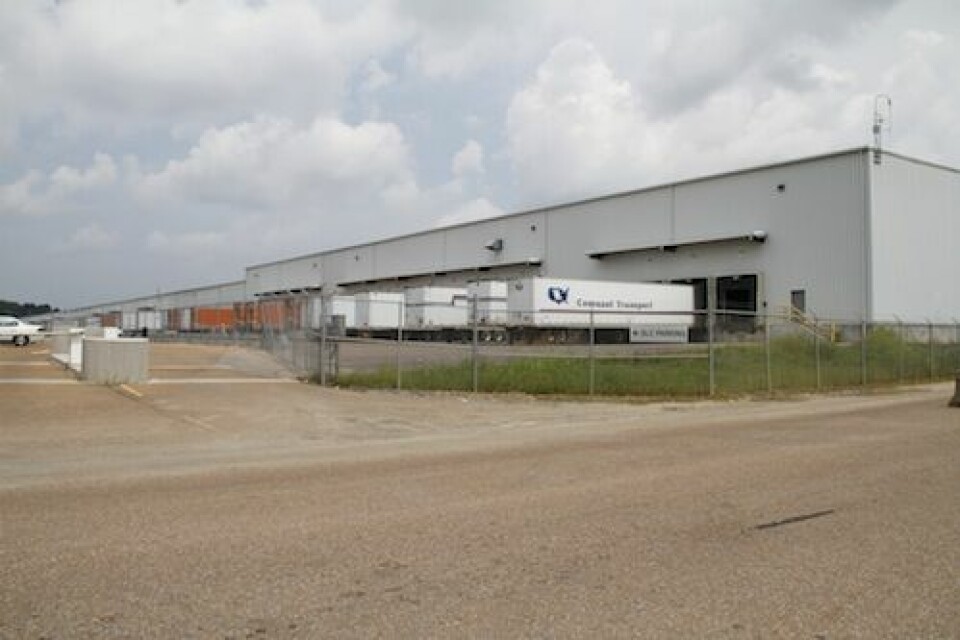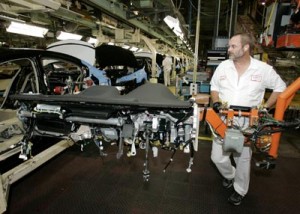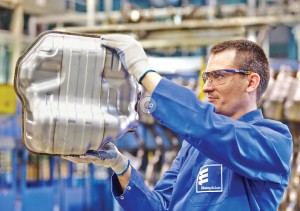When supply is a close run thing
Carmakers are showing a renewed interest in local supply networks, but do the benefits of supplier proximity balance the costs for both sides, or is there a middle distance to be found for a win-win?
The evolution of automotive manufacturing has mostly been a story of dis-integration. Today’s car factories no longer take in steel and rubber at one end and churn out vehicles at the other. Instead, the modern final assembly plant is just the last node in a complex web of manufacturing activities that extends right around the world. For decades those networks have tended to become longer and more complex, as manufacturers seek to standardise their worldwide product offerings and capture the benefits of low production costs in emerging regions.
Could that trend now be going into reverse? Rapid economic growth is narrowing the cost gap between many emerging economies and their competitors elsewhere in the world. A recent study comparing total manufacturing costs by Boston Consulting Group, for example, revealed that, once combined with productivity, energy prices and currency conversions, costs for what were once reliably lower cost sourcing locations, such as China, Latin America and eastern Europe, are now similarly priced to the US. Mexico, meanwhile, is now cheaper than China, especially for American manufacturers.
Aside from manufacturing costs, carmakers have learned the hard way that long-range supply chains can be slower, less flexible and more risky than shorter ones. Now some carmakers are announcing a change of strategy; Nissan, for example, is building large-scale facilities to house supplier manufacturing operations at several of its plants in North America and Brazil. General Motors has been pushing very strongly to localise more suppliers in North America and to bring more suppliers in closer proximity of its factories. Is the industry witnessing the beginning of a return to the highly integrated manufacturing of Henry Ford’s day?

Benefits of closer ties
At first sight, the advantages of closer supplier locations are straightforward. First, there is logistics cost: it is easier and cheaper to ship raw materials or simple components than large complex assemblies. Just how much that matters depends on the size, geometric complexity and fragility of the component concerned, relative to its value. The higher the first three relative to the last, the more it makes sense to minimise travel distances. As a result, big, bulky, but relatively simple components are obvious candidates for local assembly.
“A complete exhaust system can be as much as four metres long, so it makes sense to ship those parts in pieces,” says Jon Kuiper, who spent his career at a number of tier one suppliers prior to his current role as chief executive officer at finished vehicle transport specialist Koopman Logistics Group in the Netherlands. “The further your main manufacturing location is from the customer’s plant, the more sense it makes.”
Dana McBrien, associate chief advisor for North America logistics at Honda North America, echoes the importance of component size and value as a driver for supply chain proximity. “In our North American plants, we typically have tyre and wheel assembly activities located very close to final assembly, on our production campus, while other large parts like seats and white body parts will usually come from suppliers located within 30 miles (50km),” he notes.
Distance has a big impact on the amount of inventory required in the supply chain, too. The longer it takes to ship parts from manufacture to final assembly, the more components and containers the supplier needs in the system. If the component they supply is used in different configurations, the supply chain might need to carry even more inventory to meet unpredictable changes in demand and as insurance against delays and disruptions. Big inventories don’t just tie up cash, they also make it slower and more expensive to take action if a quality issue emerges.
Carmakers often have other reasons for asking their suppliers to set up close by, however. “Sometimes you need to invest in manufacturing close to the customer’s location to be in with a fair chance of winning the business,” says Kuiper. “The customer may want a demonstration of your long-term commitment, or they may have local content quotas to fulfil.” Local supply can also help car companies to avoid currency exchange risks, as well as minimise import taxes and duties.
A local presence can help smooth day-to-day relationships, too. Ryan Etherton is logistics manager at Eberspaecher Exhaust Technology of the Americas, which supplies exhaust systems to several US facilities for several German OEMs. “We have a facility in South Carolina that is dedicated to the BMW plant [near Spartanburg],” he explains. “Our current site is around 15 miles from the customer and we are moving to a larger facility later this year that is three or four miles away.”
Closer proximity – even the difference of just a few miles – helps to keep the cost of delivery down, especially for items that might be delivered several times per day or have a poor truck utilisation rate.
“The size and shape of exhaust systems mean you end up with very low truck utilisation, so short distances mean the customer saves a lot of money,” explains Etherton.
Being close can also help manufacturers and suppliers work through engineering changes and any breakpoints more easily. Etheron points out that proximity is simply “really useful for meetings and for working together on quality issues”.

Eberspaecher’s US final assembly and sequencing operations aren’t limited to its own components, as it integrates its own suppliers as well as parts sourced from other tier one suppliers. “The industry likes to source the hot and cold ends of the exhaust system from different suppliers, so we also assemble and sequence parts from competitors into complete exhaust systems,” he explains.
The same calculations that drive vehicle manufacturers to consider local sourcing are trickling down to the lower tiers of the supply chain. Eberspaecher prizes local suppliers for the transport flexibility and lean production benefits they can provide, and those advantages are increasingly being balanced against the pure production costs advantages of more distant sources. “There was a time when our procurement people would tend to go overseas on price, but today they will almost always look at local sources, too,” he says.
We need some space
Local sourcing is not a switch that can be turned on and off at will, however. Big carmakers are increasingly building models at several different sites and sharing ever larger numbers of components between models. In such cases, often neither they, nor their suppliers want to make the investment in extra tooling and manufacturing equipment necessary to produce close to every site, or to suffer the loss of scale economies that such fragmented production would require.
“In our network, where several locations build the same model, the supplier often ends up located closest to the highest volume site,” says Honda’s McBrien. “That means logistics costs may go up for the other sites, but we are looking for the lowest overall delivered cost across the network.”
In the formulas they use to make those calculations, companies have also found increasingly sophisticated ways to account for the different risks associated with longer supply chains.
"Where several locations build the same model, the supplier often ends up located closest to the highest volume site. That means logistics costs may go up for the other sites, but we are looking for the lowest overall delivered cost across the network" - Dana McBrien, Honda North America
“In general, the risk factors are low for intra-US shipments,” says McBrien, “Although we do occasionally have issues with exceptional weather, like the very heavy snows of last winter, the risks come much more into play for shipments from Mexico and overseas.”[sam_ad id=6 codes='true']
One organisation with extensive experience of carmakers’ increasingly sophisticated approach to supply chain risk is UK-based premium logistics specialist Priority Freight. Emergency logistics providers were traditionally called upon at the last minute to help carmakers recover from long-distance supply chain glitches. Today, the company’s managing director Neal Williams says organisations like his are increasingly involved at earlier stages of supply chain design, helping customers put contingency plans in place before disruptions occur.
“As the car companies improve their risk management, there is an element of commoditisation coming into even premium freight. There’s some downward pressure on prices and an expectation that you can turn on these services at the flick of a switch,” he explains.
In return for these tougher customer expectations, however, emergency freight players are benefiting from higher volumes, as expedited logistics becomes part of the overall transport mix for many supply chains.

Having to step in when things go wrong gives Williams an insight into one of the key risks to suppliers of locating close to a single customer: what happens when things don’t work out as planned. “One of our customers, a tier one supplier, was encouraged by its OEM customer to build a plant in Serbia,” he recalls. “But the expected business never materialised and the resulting costs took the supplier close to collapse.
“In another case a supplier built a plant specifically to serve a customer in Spain, but commercial conditions changed and the entire output from that plant now goes elsewhere.”
Acutely aware of these risks, some suppliers are getting increasingly cautious about spreading their manufacturing operations too thinly. “Suppliers are becoming very strategic with their site provision,” says Dave Andrea, senior vice-president, industry analysis and economics at the US-based Original Equipment Suppliers Association (OESA). “Nobody wants a return to the pre-2008 situation where there was so much overcapacity and poor utilisation across the industry. Today, there is a strong incentive to keep capacity tight and manage through the constraints.”
Keeping with the crowd
To capture the advantages of proximity without the risks, both suppliers and carmakers benefit from clustering in the same region. Serving multiple customers from the same sites is getting easier, says Andrea, as the approaches and processes used by carmakers become more common across different companies and regions. Clusters are nothing new, of course – from the Detroit region to the midlands of the UK, the German Mittelstand or the Shanghai region, they have existed as long as the industry itself – but their shape and nature are changing profoundly as car manufacturing evolves. In the US, says Honda’s Dana McBrien, the corridor between Georgia and Michigan, alongside Interstate 75, is becoming an increasingly important site for suppliers looking to serve both the traditional industry in the north of the country and newer foreign transplants in the south.
"As the car companies improve their risk management there is an element of commoditisation coming into even premium freight. There’s some downward pressure on prices and an expectation that you can turn on these services at the flick of a switch" - Neal Williams, Priority Freight
Dave Andrea agrees that the North America’s supplier clusters are evolving. “Where once the US industry was spread on aneast-west axis, that is slowly changing to north-south,” he notes, adding that certain parts of the industry, like the highly specialised tool and die makers that form an important part of the membership of his organisation, remain clustered in the northeast. Nor are the changes limited to the US, says Andrea, pointing out that Mexico’s automotive supply industry is also starting to drift south, as changes in labour, taxation and currency exchange rates erode the cost advantage enjoyed by Mexican suppliers looking to serve US customers just across the border. Such suppliers are also shifting to meet the exploding demand at new and existing Mexican final assembly plants further south.
“When we survey our members, two-thirds of them say they are looking to increase their capacity in Mexico,” he says. “And the primary driver for that investment is to serve customers in the country, rather than to replace US production.”
Clusters are becoming important in regions where the automotive industry is younger too, says Christopher Tiffany, regional vertical lead for automotive in Asia Pacific at logistics provider UTI Worldwide. “In the Asia Pacific region we are definitely seeing a move towards critical mass,” he says. “Examples are places like Gujarat in India where you see Tata, Ford and Caterpillar all building assembly plants and a host of other investment as tier suppliers follow the OEMs.”
Too close for comfort?
Even clusters can become victims of their own success, however, if the number of companies operating in one place starts to put pressure on resources. “When you choose a manufacturing site, you need to be confident that there is a sufficient local labour pool,” says Andrea. “As a supplier, you don’t want to end up competing with your customers for the same workforce, driving up costs for both sides.”
The same goes for other essentials, he notes, from energy and other utilities to transport infrastructure.
The result of these conflicting requirements in some regions has been the rise of clusters that are larger and less dense, as suppliers seek locations that are reasonably close to the largest number of potential customers while not being so close to them, or to competitors, to risk labour or infrastructure issues. For some established players, this means they are seeing even their local suppliers drifting slightly further away.
It is phenomenon that Gustavo Bonini, head of inbound logistics at truckmaker Scania Latin America, knows only too well. One of the longest established automotive players in the region, Scania has been manufacturing in São Bernardo do Campo, near to São Paul in Brazil, for more than 50 years and has built a network of suppliers located as close as 10km to its plant and as far as 1,100km in Brazil or even 2,700km including Argentina.

Today, a new generation of automotive players is setting up in Brazil, but a combination of customer demand and inward investment incentive from different regional governments is spreading those players up and down the coast of the country. Some of Scania’s established suppliers, says Bonini, might be relocating to be closer to these new customers, or building new capacity to meet expanding demand, usually on greenfield sites away from the congested towns.
In the US, Honda’s Dana McBrien recognises the same phenomenon. “The supply chain is moving a bit,” he says, “and it’s not moving closer to us, it is moving further away.”
Conscious uncoupling
Of course, carmakers and suppliers don’t just have to accept the limitations defined by their respective choice of manufacturing locations. Increasingly, players across the supply chain are looking for smart methods to make the best of both worlds. The complexity of the supply chain demonstrates that it is often a simplication to describe a company’s supply chain as ‘local’ or ‘global’.
“There are plenty of ways you can split the value chain to make it work more efficiently,” says Dave Andrea. “Some of our members are moving capital-intensive upstream activities – like casting or rough machining – abroad, but doing the finishing and assembly work at home where they benefit from the skills, technical support and proximity to their customers.”
"Suppliers are becoming very strategic with their site provision...there is a strong incentive to keep capacity tight and manage through the constraints" - Dave Andrea, Original Equipment Suppliers Association
Other organisations are making use of vendor-managed-inventory or third party assembly and sequencing services to give them a ‘virtual’ presence in close proximity to their customers. UTI, says Christopher Tiffany, is running inbound just-in-time, just-in-sequence services that combine parts from up to 30 suppliers, while exploring similar services for 60-80 suppliers. At Scania, Gustavo Bonini is working with suppliers to fine tune order quantities to maximise truck utilisation, as well as balancing safety stocks with the number of parts in transit to improve supply reliability, while reducing the amount of inventory in the system, particularly for suppliers located far away from the plant.
At Honda, says Dana McBrien, the evolution of manufacturing strategy may push the adoption of more of this sort of technique. “We have an emphasis on reducing cycle time: getting the keys faster into the customer’s hands,” he notes. “One way to do that is by increasing parts inventories, but another is a situation where you do the final assembly of more components close to your plants, even if the original source of supply is further away.”
Ultimately, most of these trends are good news for logistics providers. While tomorrow’s automotive supply chains may shift fewer parts over long distances, they are unlikely to be so tightly coupled that third party transport providers are squeezed out altogether. Instead, the best players will find plenty of opportunities to offer a host of value-added services that help carmakers and their suppliers find the right balance between proximity and distance.






